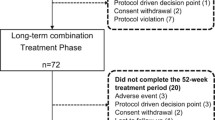Summary
A randomized multicentre between-patient study comparison has been made of the efficacy and tolerability of cadralazine and prazosin, both administered for 6 weeks to hypertensive patients with a supine diastolic blood pressure (DBP) ≥ 95 mm Hg whilst on a beta-adrenoceptor-blocker. The doses of the beta-adrenoceptor-blocker (metoprolol SR 200 mg once daily) and cadralazine (10 mg once daily) were held constant during the study, while prazosin was individually titrated from 0.5 mg to a maximum of 2 mg tds.
108 patients (50 m and 58 f; mean age 54 y) were enrolled in 12 centres. Twelve patients withdrew due to adverse effects or poor efficacy (5 patients on prazosin and 7 on cadralazine).
Both treatments induced a similar significant reduction in systolic blood pressure (SBP) and DBP, allowing normalization of BP in 58% of subjects on cadralazine and 55% on prazosin. Heart Rate (hR) increased significantly from 67 to 72 beats · min−1 in those on cadralazine and from 65 to 69 beats · min−1 on prazosin. Body weight was unchanged.
Adverse effects were mild and typical of vasodilators, such as headache, flushing and dizziness. Physician evaluation of drug efficacy was not different between drugs, and cadralazine was rated better in terms of tolerability.
Thus, in this multicentre study, cadralazine in the fixed dose of 10 mg once daily, as a second-step antihypertensive treatment in patients not satisfactorily controlled by a beta-adrenoceptor-blocker, was as effective and showed a similar side effect profile to prazosin given three times daily.
Similar content being viewed by others
References
Semeraro C, Dorigotti L, Banfi S, Carpi C (1981) Pharmacological studies on cadralazine: a new antihypertensive vasodilator drug. J Cardiovasc Pharmacol 62: 455–467
van Brummelen P, Bühler FR, Kiowski W, Bolli P, Bertel O (1979) Antihypertensive efficacy of a new long acting hydralazine like vasodilator, ISF 2469 in combination with a beta-blocker and a diuretic. Int J Clin Pharmacol Ther Toxicol 17: 380–385
Pirrelli A, Nardecchia A, Pieri R, Motolese M (1984) Cadralazine in the treatment of mild and moderate hypertension. Curr Ther Res 36: 712–719
Salvadeo A, Villa G, Segagni S et al. (1985) Cadralazine, a new vasodilator, in addition to a beta-blocker for long-term treatment of hypertension. Arzneim Forsch/Drug Res 35: 623–625
Catalano M, Parini J, Libretti A (1983) Cadralazine (ISF 2469): dose related antihypertensive activity after single oral administration to patients. Eur J Clin Pharmacol 24: 157–161
Corea L, Valori C, Bentivoglio M et al. (1983) A dose-response study on the antihypertensive activity of once-daily cadralazine. J Hypertens 1 [Suppl 2]: 362–364
Buoninconti R, Motolese M (1985) Antihypertensive activity of a new vasodilator, cadralazine, administered alone or in combination with a beta-blocker. Int J Clin Pharmacol Ther Toxicol 23: 613–616
Strocchi E, Costa FV, Caldari R et al. (1983) Comparison of the antihypertensive activity of cadralazine (ISF 2469) and dihydralazine during chronic treatment. Int J Clin Pharmacol Ther Toxicol 21: 519–523
Catalano M, Parini J, Romano M, Libretti A (1985) Controlled clinical trial of cadralazine as a second-step drug in the treatment of hypertension. Eur J Clin Pharmacol 28: 135–138
Katila M, Frick MH (1970) Combined dihydralazine and propranolol in the treatment of hypertension. Int J Clin Pharmacol Ther Toxicol 4: 111–114
Hansson L, Olander R, Åberg H, Malmcrona R, Westerlund A (1971) Treatment of hypertension with propranolol and hydralazine. Acta Med Scand 190: 531–534
Gottlieb TB, Katz FH, Chidsey CA (1972) Combined therapy with vasodilator drugs and beta-adrenergic blockade in hypertension. Circulation 45: 571–582
Eggertsen R, Hansson L (1985) Vasodilators in hypertension: a review with special emphasis on the combined use of vasodilators and beta-adrenoceptor blockers. Int J Clin Pharmacol Ther Toxicol 23: 411–423
Bouthier JA, Safar ME, Curien ND, London FM, Levenson JA, Simon AC (1986) Effect of cadralazine on brachial artery hemodynamics and forearm venous tone in essential hypertension. Clin Pharmacol Ther 39: 82–88
Persson B, Granerus G, Wysocki M, Hedner T, Andersson OK (1987) Acute systemic and renal haemodynamic effects and long-term antihypertensive action of cadralazine in patients pretreated with beta-blockers and diuretics. Eur J Clin Pharmacol 31: 513–518
Okun R (1983) Effectiveness of prazosin as initial antihypertensive therapy. Am J Cardiol 51: 644–650
Stanaszek WF, Kellermann D, Brogden RM, Romankiewicz JA (1983) Prazosin update. A review of its pharmacological properties and therapeutic use in hypertension and congestive heart failure. Drugs 25: 339–384
Semplicini A, Pessina AC, Caregaro L et al. (1983) Blood pressure, body fluids and renal tubular handling of sodium during cadralazine plus atenolol in essential hypertension. Curr Ther Res 34: 1038–1043
Colucci WS (1982) Alpha-adrenergic receptor blockade with prazosin. Consideration of hypertension, heart failure and potential new applications. Ann Intern Med 97: 67–77
Koshy NC, Mickley D, Bourgoigne J, Blaufox MD (1977) Physiologic evaluation of a new antihypertensive agent: prazosin HCl. Circulation 55: 533–537
Dustan MP, Taylor RD, Corcoran A, Page IH (1954) Rheumatic and febrile syndrome during prolonged hydralazine treatment. JAMA 154: 670–673
Marshall AJ, McGraw ME, Barritt DW (1979) Positive antinuclear factor test with prazosin. Br Med J 278: 165–166
Andersson OK (1987) Cadralazine did not produce the SLE-syndrome when hydralazine did. Eur J Clin Pharmacol 31: 741
Author information
Authors and Affiliations
Additional information
For the Italian Multicentre Study Group
Participating Centres: C. Canale, V. Terrachini (Genova); G. Paoletti, A. Camerieri (Sestri Ponente); G. Gandolfi (La Spezia); A. Castelluccio, C. Mondelli (S. Remo); G. Maschio, V. Bedogna (Verona); A. Spedo (Badia Polesine); P. Cantù, A. Limido (Gallarate); F. Valentini (Como); G. Viglino (Alba); C. Martines, E. Casiglia (Piove di Sacco); R. Miori, M. Dalfollo (Trento); P. Maiolino, A. Carrozza (Cittadella)
Rights and permissions
About this article
Cite this article
Caponnetto, S., Valvo, E., Mocarelli, P. et al. Cadralazine versus prazosin as second-step treatment in hypertensive patients on beta-blockers: a randomized multicentre study. Eur J Clin Pharmacol 40, 461–465 (1991). https://doi.org/10.1007/BF00315223
Received:
Accepted:
Issue Date:
DOI: https://doi.org/10.1007/BF00315223




